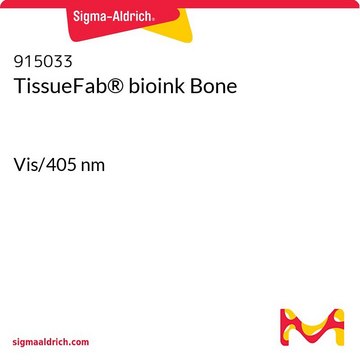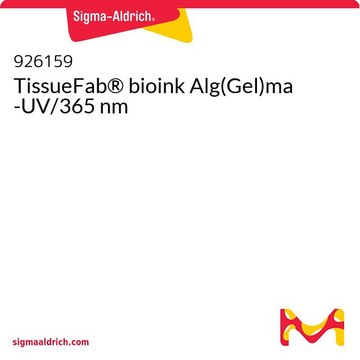926035
TissueFab® bioink Bone UV/365 nm
Sinonimo/i:
3D Bioprinting, Bioink, GelMA, TissueFab
Autenticatiper visualizzare i prezzi riservati alla tua organizzazione & contrattuali
About This Item
Codice UNSPSC:
12352201
NACRES:
NA.23
Prodotti consigliati
Forma fisica
viscous liquid
Livello qualitativo
Impurezze
<5 CFU/g Bioburden (Total Aerobic)
<5 CFU/g Bioburden (fungal)
<50 EU/mL Endotoxin
Colore
white
pH
6.5-7.5
Viscosità
5-50 cP(37 °C)
applicazioni
3D bioprinting
Descrizione generale
TissueFab® bioink Bone Vis/405 nm, is designed for promoting osteogenic differentiation of stem cells. It is based on Gelatin methacryloyl (GelMA) - Hydroxyapatite (HAp) hydrogel system.
HAp is a highly crystalline form of calcium phosphate. HAp has a chemical similarity with the mineralized phase of bone which accounts for their excellent biocompatibility and osteoinductive and osteoconductive properties favorable for bone regeneration. HAp-containing hydrogels has been studied in literature to demonstrate their processability with different additive manufacturing approaches. Printing of cell laden structures with HAp containing bioink formulations have shown superior osteogenic properties.
Additional Information:
The protocol for this material can be found In the Documentation Section under ″More Documents″.
HAp is a highly crystalline form of calcium phosphate. HAp has a chemical similarity with the mineralized phase of bone which accounts for their excellent biocompatibility and osteoinductive and osteoconductive properties favorable for bone regeneration. HAp-containing hydrogels has been studied in literature to demonstrate their processability with different additive manufacturing approaches. Printing of cell laden structures with HAp containing bioink formulations have shown superior osteogenic properties.
Additional Information:
The protocol for this material can be found In the Documentation Section under ″More Documents″.
Applicazioni
TissueFab® bioink Bone UV/365 nm, low endotoxin is a ready-to-use bioink which is formulated for high cell viability, osteoinduction and printing fidelity and is designed for extrusion-based 3D bioprinting and subsequent crosslinking with exposure to 405 nm visible light. GelMA-Bone bioinks can be used with most extrusion-based bioprinters, are biodegradable, and are compatible with human mesenchymal stem cells (hMSCs) and osteogenic cell types. TissueFab® bioink Bone UV/365 nm, low endotoxin enables the precise fabrication of osteogenic 3D cell models and tissue constructs for research in 3D cell biology, tissue engineering, in vitro tissue models, and regenerative medicine.
Note legali
TISSUEFAB is a registered trademark of Merck KGaA, Darmstadt, Germany
Codice della classe di stoccaggio
10 - Combustible liquids
Classe di pericolosità dell'acqua (WGK)
WGK 3
Scegli una delle versioni più recenti:
Certificati d'analisi (COA)
Lot/Batch Number
Ci dispiace, ma al momento non ci sono COA disponibili online per questo prodotto.
Se ti serve aiuto, non esitare a contattarci Servizio Clienti
Possiedi già questo prodotto?
I documenti relativi ai prodotti acquistati recentemente sono disponibili nell’Archivio dei documenti.
Mehdi Sadat-Shojai et al.
Materials science & engineering. C, Materials for biological applications, 49, 835-843 (2015-02-18)
The ability to encapsulate cells in three-dimensional (3D) protein-based hydrogels is potentially of benefit for tissue engineering and regenerative medicine. However, as a result of their poor mechanical strength, protein-based hydrogels have traditionally been considered for soft tissue engineering only.
Yicong Zuo et al.
ACS applied materials & interfaces, 7(19), 10386-10394 (2015-05-01)
Modular tissue engineering holds great potential in regenerating natural complex tissues by engineering three-dimensional modular scaffolds with predefined geometry and biological characters. In modular tissue-like construction, a scaffold with an appropriate mechanical rigidity for assembling fabrication and high biocompatibility for
Xi Chen et al.
International journal of nanomedicine, 11, 4707-4718 (2016-10-04)
Periodontitis is a chronic infectious disease and is the major cause of tooth loss and other oral health issues around the world. Periodontal tissue regeneration has therefore always been the ultimate goal of dentists and researchers. Existing fabrication methods mainly
Michal Bartnikowski et al.
Materials (Basel, Switzerland), 9(4) (2016-04-14)
The concept of biphasic or multi-layered compound scaffolds has been explored within numerous studies in the context of cartilage and osteochondral regeneration. To date, no system has been identified that stands out in terms of superior chondrogenesis, osteogenesis or the
Janet R Xavier et al.
ACS nano, 9(3), 3109-3118 (2015-02-13)
Despite bone's impressive ability to heal after traumatic injuries and fractures, a significant need still exists for developing strategies to promote healing of nonunion defects. To address this issue, we developed collagen-based hydrogels containing two-dimensional nanosilicates. Nanosilicates are ultrathin nanomaterials
Il team dei nostri ricercatori vanta grande esperienza in tutte le aree della ricerca quali Life Science, scienza dei materiali, sintesi chimica, cromatografia, discipline analitiche, ecc..
Contatta l'Assistenza Tecnica.








